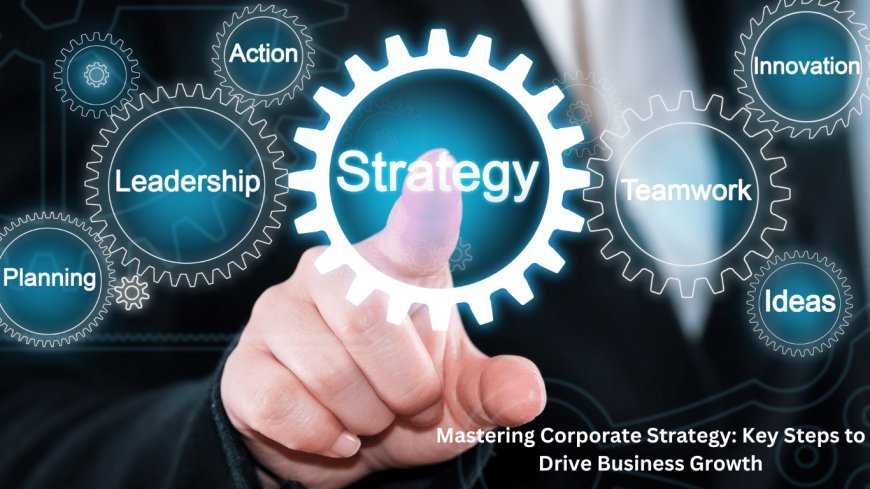Mastering Corporate Strategy: Key Steps to Drive Business Growth
Discover how to master corporate strategy with practical steps that fuel business growth. Learn key strategies, insights, and tips to boost your business success.

Mastering Corporate Strategy: Key Steps to Drive Business Growth
Corporate strategy is essential for success in today's fast-changing business climate. Unfortunately, company planning may be difficult, market trends change, and competition rises. What can a company do to thrive?
A systematic, complete business strategic planning technique works. If you're a startup or existing firm, you need a clear and effective corporate plan to grow up, stay competitive, and flourish.
This blog will help you understand corporate strategy and grow your business.
Step 1: Define Clear Business Goals
Any great business plan begins with definable goals. Strategy without objectives is just a collection of ideas, not a growth plan.
Why is this step so important?
Your objective helps you focus resources, make wise decisions, and unify your team. Development and success assessment are easier with clear goals.
How to Define Goals:
-
Be Specific: Instead of vague objectives like “increase revenue,” be more specific: “Increase revenue by 15% within the next 12 months.”
-
Make Goals Measurable: Set benchmarks so you can track your progress.
-
Align Goals with the Mission: Your goals should reflect your company’s long-term mission and vision. Make sure everyone in your organization is on the same page.
Step 2: Understand Your Market and Competitive Landscape
Knowing your industry and competitors is crucial to business strategy. Navigation without this understanding is like without a map.
How Market Research Shapes Strategy:
-
Know Your Competitors: Who are your main competitors? What are they doing well, and where are they failing? This information helps you spot opportunities and weaknesses in the market.
-
Identify Market Trends: Staying on top of market trends allows you to anticipate changes and position yourself accordingly.
-
Target Audience: A deep understanding of your target audience will help tailor your strategy to meet their needs and expectations.
Tools for Competitive Analysis:
-
Assessment of strengths, weaknesses, opportunities, and threats
-
Political, Economic, Social, and Technological analysis
-
The Porter Five Forces analysis
You may capture fresh opportunities by staying ahead of the competition and adjusting to market developments.
Step 3: Leverage Technology and Innovation
Digital development is driven by technology. Technology simplifies procedures and improves customer experiences, helping organizations prosper.
Why Technology Matters:
-
Automation: Reduces manual tasks, improves efficiency, and cuts costs.
-
Data-Driven Insights: Technology helps you collect and analyze data to make informed decisions.
-
Innovation: Embracing innovation leads to new product offerings, improved services, and better customer engagement.
How to Implement Technology into Your Strategy:
-
Purchase CRM solutions to better understand and service customers.
-
Track performance and improve plans via data analytics.
-
Try AI to automate tedious chores and personalize consumer encounters.
Companies that use technology simplify operations and gain a competitive edge for long-term success.
Step 4: Build a Strong Leadership Team
Effective plans need strong leadership teams. Without solid execution, even the finest organization strategy will fail. Leadership is needed.
Role of Leadership in Strategy Execution:
Leaders tailor the strategy to corporate culture, values, and resources. They encourage firm ownership and employee motivation.
Key Leadership Qualities for Strategic Success:
-
Visionary Thinking: Leaders must be forward-thinking to guide businesses through uncertainty.
-
Communication:Good leaders properly communicate the plan to the team to ensure alignment and understanding of their roles in execution.
-
Decision-Making:Keep the plan on track with quick, informed judgments.
Your executives must be skilled, experienced, and adaptable to company changes. Leadership development enhances your company's future.
Step 5: Foster a Culture of Adaptability and Continuous Learning
Corporate strategy success demands adaptation to changing business conditions. Non-adapters risk falling behind since last year's approaches may not work.
Why Adaptability Is Key:
Staying Relevant: Businesses must continually adjust their tactics due to fast-changing technology and industry trends.
Encouraging Innovation:Encourage staff to think creatively and accept fresh ideas.
How to Promote a Learning Culture:
-
Encourage Feedback: To enhance your plan, regularly solicit employee and consumer input.
-
Invest in Training:Provide ongoing training for your workforce to manage changing issues.
-
Celebrate Innovation:Reward innovation in your company.
A flexible and inventive culture helps your organization stay competitive and pivot.
Step 6: Implement Measurable Metrics for Progress
Monitoring and upgrading work best. Without measuring progress, how can you determine whether your strategy works?
Setting KPIs and Tracking Performance:
Key Performance Indicators (KPIs) assess your progress toward targets. These might be revenue growth, market share, customer retention, or other metrics.
Use Data to Drive Decisions: Monitor your KPIs and company statistics to make data-driven choices and adapt your strategy.
Common KPIs to Track:
-
Cost of customer acquisition
-
Customer lifetime value
-
Worker productivity
-
Profit margins
Regular performance reviews help you stay on target and alter your strategy.
Takeaways: Mastering Corporate Strategy for Growth
Business strategy involves precision, adaptability, and vision, not just preparedness. Setting goals, understanding the market, employing technology, developing strong leadership, supporting adaptability, and using quantitative measures will help your organization grow.
A strategy must be polished to be perfect. Your company can foresee new opportunities and overcome obstacles with a well-planned strategy.
Ready to learn corporate strategy and grow your business?
FAQs
Q1: How often should a corporate strategy be reviewed?
A1Companies should evaluate their strategies annually, but fast-changing industries require more frequent assessments.
Q2: What’s the most important factor in successful strategy execution?
A2:Leadership matters. Strong leadership communicates and implements the strategy company-wide.
Q3: Can a small business benefit from a corporate strategy?
A3:Absolutely! A clear strategy helps small businesses focus and grow.

 Najmul Hasan
Najmul Hasan 





